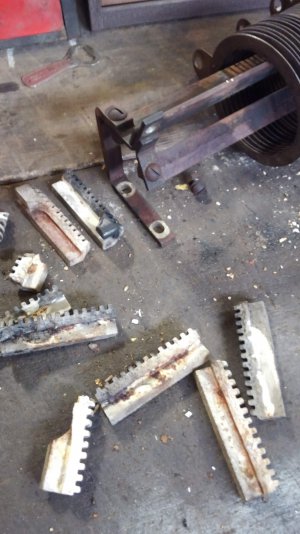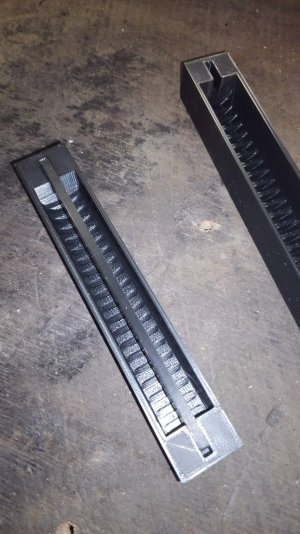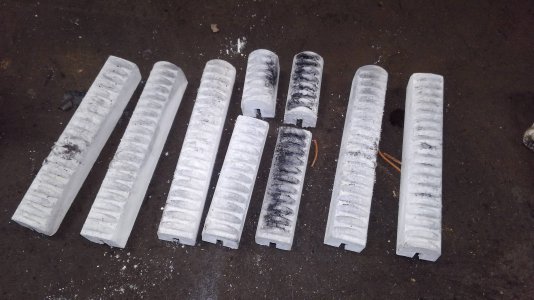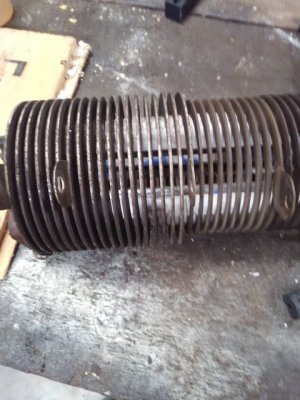Hi All: I've been lurking here for a while and wanted to share a problem I encountered recently and my solution. I purchased a Hobart welder generator for 215 bucks which included 100 ft cables, tig setup and 4 ft tall argon bottle. Long story short, used by milking machine repairman who needed stainless steel repair capabilities. Fellow died 15 years ago and family was going to scrap. One of those "it ran" projects. So it needed everything from valves unstuck, corroded connectors repaired etc.
The object of this post was broken ceramic insulators in the large resistor coil for the welder to adjust welding amps. There were all cracked, some missing and are no longer available. This is a characteristic issue for these welders which has ended the service of countless of these units. These are long u shaped pieces which separate the turns of the resistor and insulate them from the supporting steel bars.
So I made a sample insulator using fusion 360 with some changes such as increasing length so less insulators are used and to decrease interior channel width to add some strength.
Once I confirmed fitment, I made a pla mold. I chose an open one piece mold with a single bar insert for the channel. I cast the parts using Rescor 750 (a castable ceramic) from McMaster -listed as shock proof castable ceramic. When mixed per directions, this is curable at room temp but requires heating to 225 f for 2 hours to strengthen. Firing to higher temps gives more strength. Instead of demolding parts, I simply melted the mold off the parts as part of the curing since I didn't design any draft into my mold. I used a BBQ grill and a thermometer and over 6 hours heated progressively to 500 degrees. Melted PLA smells surprisingly like a berry pie in the oven. I subsequently fired the parts to 1100 f in an incinerating toilet (incinolet) since I don't have a kiln. The finished parts fit correctly and the welder has been returned to service. These parts are good to 2700 degrees per instructions. If I had access to a kiln and fired to 2200 degrees, the parts would have been even stronger.
For what it's worth, the mold is posted on my thingaverse page.
Picture 1 is broken insulators Picture 2 is PLA mold. Picture 3 is after melting off mold. Picture 4 is assembled ballast resistor.
The object of this post was broken ceramic insulators in the large resistor coil for the welder to adjust welding amps. There were all cracked, some missing and are no longer available. This is a characteristic issue for these welders which has ended the service of countless of these units. These are long u shaped pieces which separate the turns of the resistor and insulate them from the supporting steel bars.
So I made a sample insulator using fusion 360 with some changes such as increasing length so less insulators are used and to decrease interior channel width to add some strength.
Once I confirmed fitment, I made a pla mold. I chose an open one piece mold with a single bar insert for the channel. I cast the parts using Rescor 750 (a castable ceramic) from McMaster -listed as shock proof castable ceramic. When mixed per directions, this is curable at room temp but requires heating to 225 f for 2 hours to strengthen. Firing to higher temps gives more strength. Instead of demolding parts, I simply melted the mold off the parts as part of the curing since I didn't design any draft into my mold. I used a BBQ grill and a thermometer and over 6 hours heated progressively to 500 degrees. Melted PLA smells surprisingly like a berry pie in the oven. I subsequently fired the parts to 1100 f in an incinerating toilet (incinolet) since I don't have a kiln. The finished parts fit correctly and the welder has been returned to service. These parts are good to 2700 degrees per instructions. If I had access to a kiln and fired to 2200 degrees, the parts would have been even stronger.
For what it's worth, the mold is posted on my thingaverse page.
Picture 1 is broken insulators Picture 2 is PLA mold. Picture 3 is after melting off mold. Picture 4 is assembled ballast resistor.






